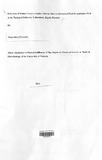| dc.contributor.author | Ntagwabira, E | |
| dc.date.accessioned | 2013-09-27T11:28:42Z | |
| dc.date.available | 2013-09-27T11:28:42Z | |
| dc.date.issued | 2011 | |
| dc.identifier.citation | Ntagwira,E.,2011.Detection of human herpes simplex virus in clear cerebrospinal fluid by multiplex PCR at the Natiobal Reference Laboratory,Kigali,Rwanda. | en |
| dc.identifier.uri | http://erepository.uonbi.ac.ke:8080/xmlui/handle/123456789/57128 | |
| dc.description.abstract | Background: More than 80% of the clear cerebrospinal fluid (CSF) submitted to the
National Reference Laboratory (NRL) , Centre Hospital University Kigali and King Faysal
Hospital in Kigali, Rwanda, are found to be negative for Cryptococcus neoformans and
Mycobacterium tuberculosis, the only microorganisms tested for at this facility. These
samples are obtained from patients with clinical suspicion of meningitis and encephalitis,
which may be caused by different microorganisms including herpes viruses. The purpose of
this study was to test CSF obtained from different regions of Rwanda for human herpes
simplex viruses (HSV) type 1 (HSV -1) and type 2 (HSV -2) using a commercial multiplex
PCR kit. The objective of this study was to determine the prevalence ofHSV in clear CSF in
Rwanda and to demonstrate that HSV -1 and HSV -2 can be PCR co-amplified in the same
reaction tube.
Methodology: Clear CSF was obtained from patients with clinical suspicion of meningitis
and encephalitis from five provinces in Rwanda. All the samples were transported to the NRL
for DNA extraction and then subjected to multiplex PCR for detection of HSV -1 and HSV -2.
The PCR amplicons were resolved on 2% agarose gels and bands corresponding to HSV-l,
HSV -2, and the internal control identified under ultra-violet (UV) light.
Results: A total of 196 clear CSF samples were analyzed with this assay. Eleven out of 196
samples (5.6%) tested positive for Cryptococcus neoformans based on information supplied
by medical officers where CSF originated. Of these samples, 7 (4.3%) were positive for
HSV-l, 12 (6.0%) for HSV-2. 2 (1.0%) were dually infected with both HSV-l and HSV-2.
Overall, 21 out of 196 samples (10.7%) were positive for HSV nationally.
Conclusion: Multiplex PCR for diagnosis of HSV -1 and HSV -2 in clinical specimens (CSF)
was found to be rapid and specific at the NRL. Demonstration of viral DNA detection by
PCR is a major milestone as this provides a platform to the NRL to institute viral diagnostic
procedures using PCR. The prevalence of HSV in CSF in this study is high enough (l 0.7%)
to prompt the NRL to undertake a validation of the assay so that it can be adapted for routine
HSV diagnosis in the laboratory. Once validation of the assay is done, its implementation at
this referral laboratory will provide advisory leadership to physicians on whom patients can
effectively benefit from available anti-HSV drugs like acyclovir, hence improving the quality
oflife for all Rwandese and its neighbours. | en |
| dc.language.iso | en | en |
| dc.publisher | University of Nairobi | en |
| dc.title | Detection of human herpes simplex virus in clear cerebrospinal fluid by multiplex PCR at the Natiobal Reference Laboratory,Kigali,Rwanda | en |
| dc.type | Thesis | en |
| local.publisher | College of Biological and Physical Sciences | en |

